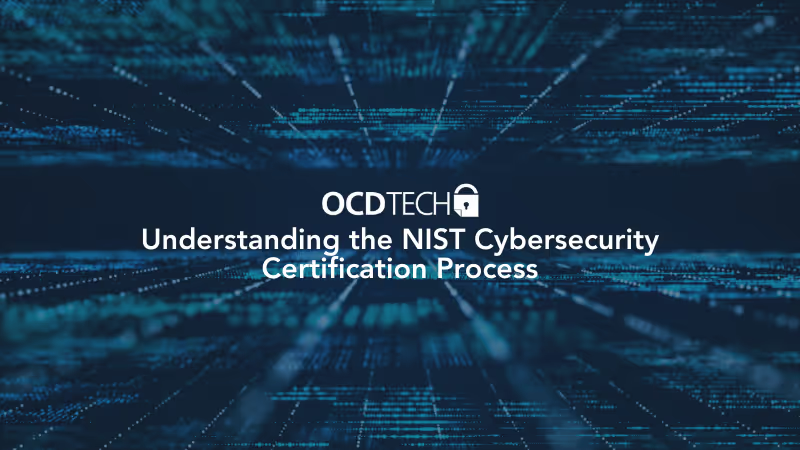By
OCD Tech
November 27, 2025
•
2
min read

Organizations rely on digital systems more than ever, but many struggle to measure whether their defenses are actually effective. The NIST Cybersecurity Framework (CSF) solves that problem by giving businesses a clear, structured way to evaluate risks, strengthen defenses, and build long-term resilience. Understanding how the certification process works—especially since NIST itself does not certify—helps organizations choose the right path to formal validation.
Created by the National Institute of Standards and Technology, the NIST CSF offers a unified guide for managing cybersecurity risks across industries. Its five core functions form the backbone of any strong program:
Identify — Clarify risks to systems, assets, data, and capabilities.
Protect — Implement safeguards that keep essential operations secure.
Detect — Ensure the organization can spot anomalies and attacks quickly.
Respond — Take action to contain and mitigate cybersecurity incidents.
Recover — Restore affected services and strengthen resilience after an event.
These functions help organizations build a program tailored to their environment, maturity level, and risk profile.
Adopting the NIST CSF brings benefits beyond compliance checkboxes:
Enhanced Security Posture
Using the CSF framework uncovers vulnerabilities, strengthens controls, and reduces exposure to cyber threats.
Regulatory Compliance
Many regulatory frameworks align with or reference NIST CSF principles—including GDPR, HIPAA, and industry-specific data protection requirements.
Improved Risk Management
The CSF gives leaders a methodical way to prioritize investments based on impact, likelihood, and business objectives.
Stronger Customer and Partner Trust
Third-party certification based on NIST CSF signals credibility and commitment to cybersecurity excellence.
Because NIST does not issue certifications, organizations rely on accredited third parties to validate their alignment with the CSF. The typical journey includes the following steps:
Evaluate your existing policies, controls, and processes using the CSF as a baseline. This helps pinpoint strengths, weaknesses, and immediate gaps.
Translate your assessment into a roadmap. Prioritize improvements based on risk severity, business impact, and resource availability.
Update policies, deploy technologies, enhance monitoring practices, and train teams to ensure proper adoption of new controls.
Track KPIs, conduct periodic reviews, and refine your cybersecurity posture as systems and threats evolve.
Engage a qualified assessor to review your CSF implementation. If requirements are met, the assessor issues a certification validating your alignment.
Strengthening cybersecurity requires education and ongoing development. Organizations commonly rely on:
Online Courses
Courses covering NIST CSF concepts, implementation techniques, and risk management practices.
Workshops and Seminars
Hands-on sessions led by cybersecurity practitioners that offer practical insights and real-world examples.
NIST Publications
Official guidelines, case studies, and best practices that help teams adopt the framework accurately and effectively.
Pursuing NIST CSF-based certification equips organizations with a structured approach to managing threats, improving compliance, and earning stakeholder trust. With the right planning, training, and validation, the framework becomes more than a checklist—it becomes a roadmap for continuous cybersecurity maturity and resilience.

Audit. Security. Assurance.
IT Audit | Cybersecurity | IT Assurance | IT Security Consultants – OCD Tech is a technology consulting firm serving the IT security and consulting needs of businesses in Boston (MA), Braintree (MA) and across New England. We primarily serve Fortune 500 companies including auto dealers, financial institutions, higher education, government contractors, and not-for-profit organizations with SOC 2 reporting, CMMC readiness, IT Security Audits, Penetration Testing and Vulnerability Assessments. We also provide dark web monitoring, DFARS compliance, and IT general controls review.
Contact Info
.svg)
OCD Tech
.svg)
25 BHOP, Suite 407, Braintree MA, 02184
.svg)
844-623-8324
.svg)
https://ocd-tech.com
Follow Us
Videos
Check Out the Latest Videos From OCD Tech!
Services
SOC Reporting Services
– SOC 2 ® Readiness Assessment
– SOC 2 ®
– SOC 3 ®
– SOC for Cybersecurity ®
IT Advisory Services
– IT Vulnerability Assessment
– Penetration Testing
– Privileged Access Management
– Social Engineering
– WISP
– General IT Controls Review
IT Government Compliance Services
– CMMC
– DFARS Compliance
– FTC Safeguards vCISO